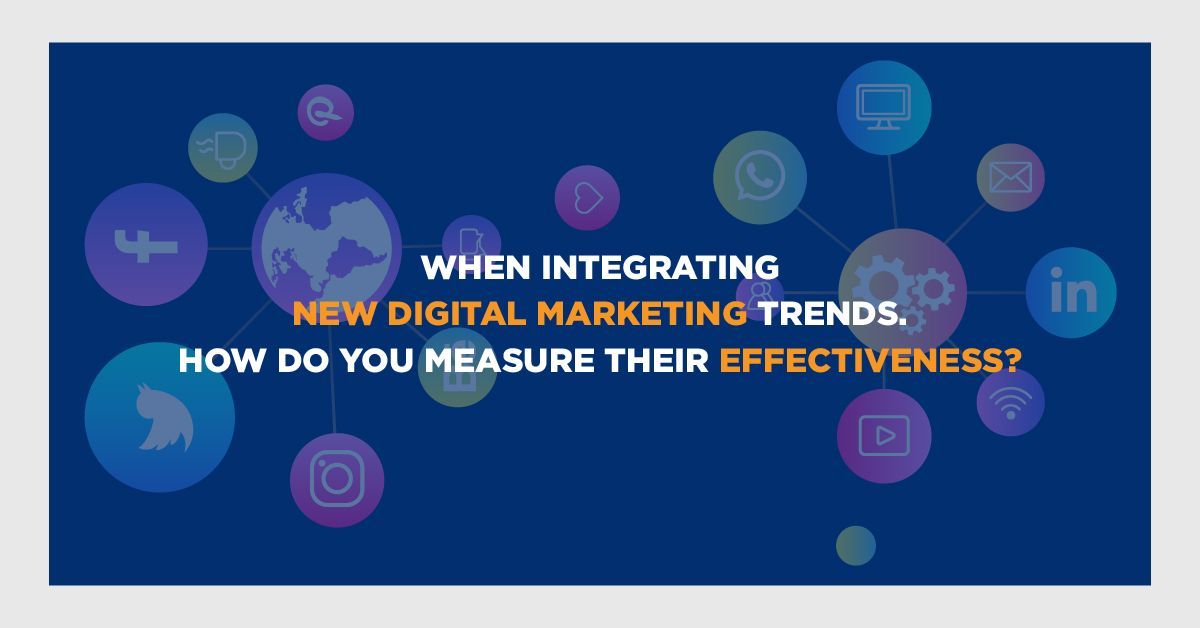When integrating new digital marketing trends. How do you measure their effectiveness?
Gokulram M • February 19, 2025

When integrating new digital marketing trends. How do you measure their effectiveness?
Measuring the Effectiveness of New Digital Marketing Trends
As digital marketing constantly evolves, businesses must stay ahead by integrating new trends. However, adopting a trend without measuring its impact can lead to wasted resources. Below is a structured approach to effectively evaluate the success of a new digital marketing trend.
1. Define Objectives and Goals
Before implementing a new trend, establish clear and measurable goals. Common objectives include:
- Increasing brand awareness (e.g., more impressions, social shares, media mentions)
- Boosting engagement (e.g., higher click-through rates, likes, comments, shares)
- Generating leads (e.g., form submissions, email sign-ups, downloads)
- Driving sales and conversions (e.g., purchase rate, average order value, return on investment)
Aligning goals with broader marketing strategies ensures that the trend contributes to business growth.
2. Identify Key Performance Indicators (KPIs)
KPIs help track progress and determine if the new trend is effective. Choose the right KPIs based on your objectives:
Objective
Relevant KPIs
Brand Awareness - Impressions, reach, brand mentions, website traffic
Engagement - Click-through rate (CTR), social media interactions, time on site
Lead Generation - Cost per lead (CPL), sign-up rate, form submissions
Sales & Revenue - Conversion rate, return on ad spend (ROAS), customer acquisition cost (CAC)
Each KPI should be specific, measurable, and time-bound for accurate analysis.
3. Utilize Data Analytics Tools
To accurately measure effectiveness, leverage digital marketing tools:
- Google Analytics → Website traffic, bounce rate, user behavior
- Google Search Console → SEO performance, search rankings
- Facebook/Instagram Insights → Engagement metrics for social media campaigns
- LinkedIn Analytics → B2B content engagement and lead tracking
- Email Marketing Platforms (e.g., Mailchimp, HubSpot) → Open rates, click rates, conversions
- Heatmap Tools (e.g., Hotjar, Crazy Egg) → Visual insights on user interaction
These tools provide valuable insights into how users respond to new marketing strategies.
4. A/B Testing for Continuous Optimization
A/B testing (also known as split testing) compares different versions of marketing content to identify what works best.
- Example: Test two versions of a landing page (one using the new trend and another using the old strategy) to determine which converts better.
- Variables to test: Headlines, images, call-to-action (CTA) buttons, layouts, and messaging.
This method helps refine campaigns based on real user data.
5. Benchmark Against Industry Standards
Compare your results with industry benchmarks to determine if the trend is performing well.
- If performance is above average: Consider scaling the trend into your long-term strategy.
- If results are weak: Reevaluate execution or discontinue if it’s not delivering value.
Reliable sources for benchmarking include Google’s industry reports, HubSpot’s annual marketing reports, and insights from social media platforms.
6. Calculate Return on Investment (ROI)
To determine if a new digital marketing trend is profitable, use this formula:
ROI=(Revenue−Cost)Cost×100ROI = \frac{{(Revenue - Cost)}}{{Cost}} \times 100ROI=Cost(Revenue−Cost) ×100
- If ROI is positive, the trend is effective and worth expanding.
- If ROI is negative, reassess costs, execution, or audience targeting.
Other financial metrics include cost per acquisition (CPA) and customer lifetime value (CLV) to gauge long-term impact.
7. Monitor Long-Term Impact & Adapt
Marketing trends evolve, and consumer behaviors shift over time. Regular monitoring ensures that a once-successful trend remains relevant.
- Set up monthly or quarterly reports for long-term tracking.
- Adjust campaigns based on emerging data.
- Stay updated with industry shifts and customer preferences.
Conclusion
Measuring the effectiveness of new digital marketing trends requires a strategic, data-driven approach. By setting clear goals, tracking relevant KPIs, using analytics tools, and continuously optimizing campaigns, businesses can determine whether a trend is worth further investment.










